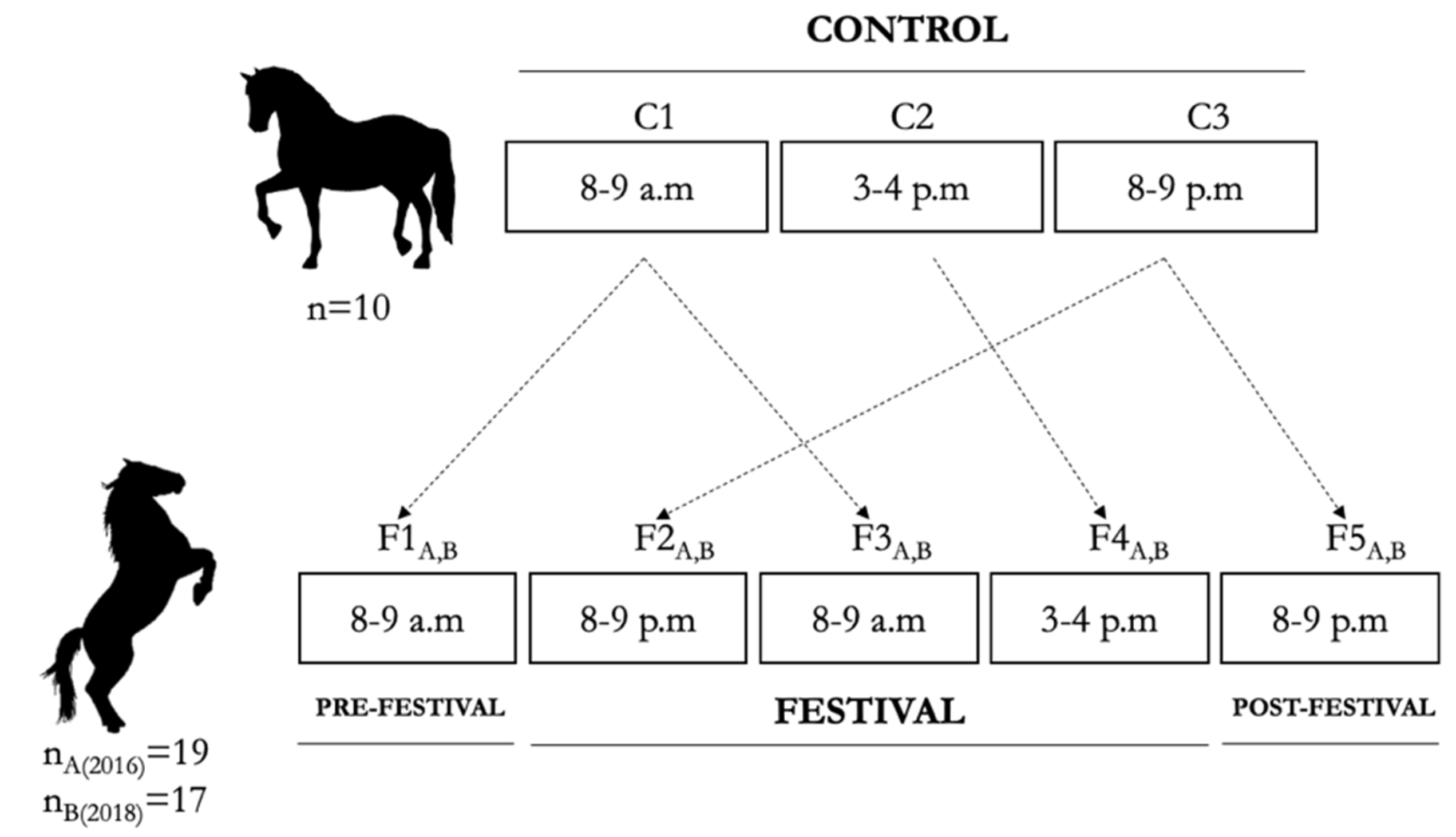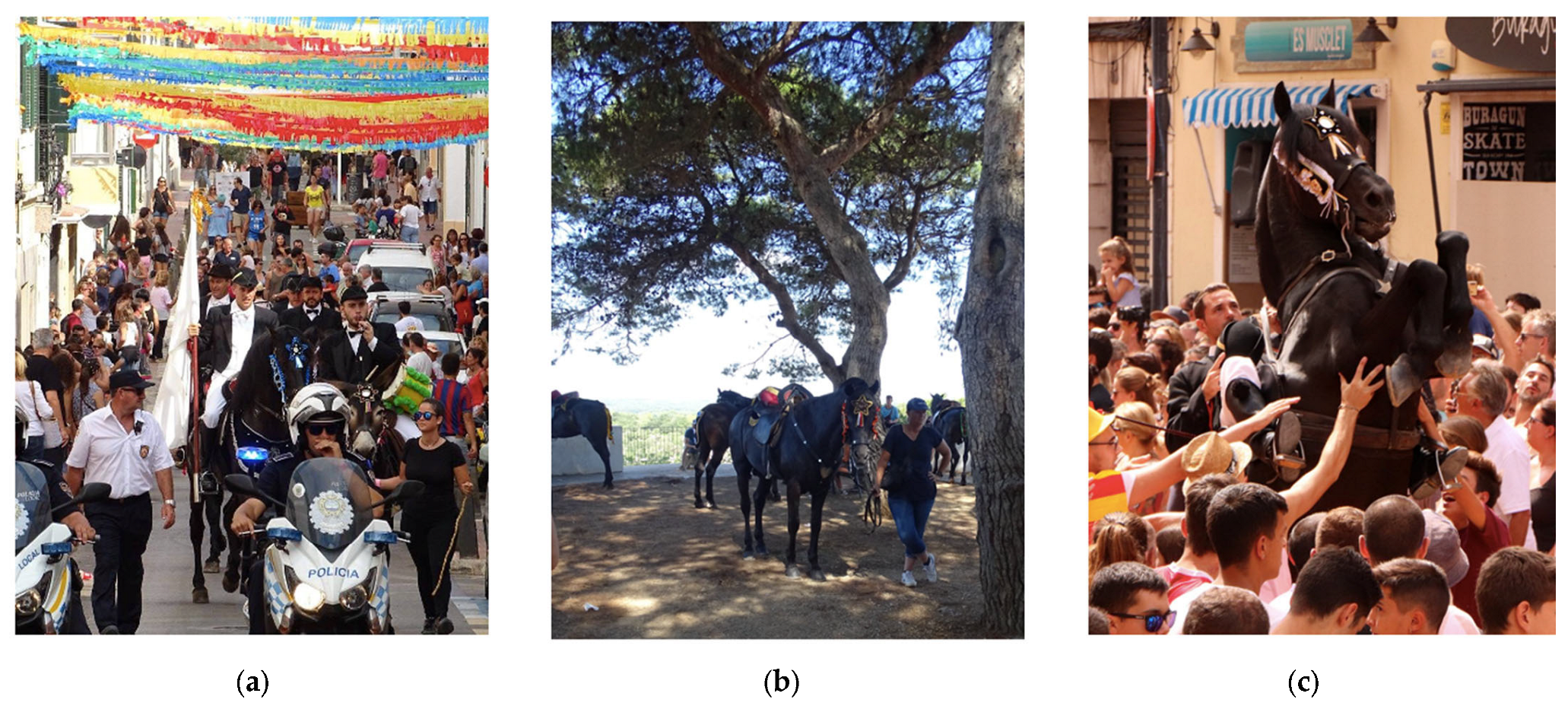Cortisol Variations to Estimate the Physiological Stress Response in Horses at a Traditional Equestrian Event
Abstract
Simple Summary
Abstract
1. Introduction
2. Materials and Methods
2.1. Celebrations
2.2. Animals, Sampling, and Ethics

2.3. Cortisol Quantification and Biochemical Validation of the Enzyme Immunoassay
2.4. Statistical Analysis
3. Results
Salivary Cortisol Concentrations
4. Discussion
5. Conclusions
Author Contributions
Funding
Institutional Review Board Statement
Informed Consent Statement
Data Availability Statement
Acknowledgments
Conflicts of Interest
References
- Pazzola, M.; Pira, E.; Sedda, G.; Vacca, G.M.; Cocco, R.; Sechi, S.; Bonelli, P.; Nicolussi, P. Responses of hematological parameters, beta-endorphin, cortisol, reactive oxygen metabolites, and biological antioxidant potential in horses participating in a traditional tournament1. J. Anim. Sci. 2015, 93, 1573–1580. [Google Scholar] [CrossRef] [PubMed]
- Solé, M.; Gómez, M.D.; Galisteo, A.M.; Santos, R.; Valera, M. Kinematic Characterization of the Menorca Horse at the Walk and the Trot: Influence of Hind Limb Pastern Angle. J. Equine Vet. Sci. 2013, 33, 726–732. [Google Scholar] [CrossRef]
- Bartolomé, E.; Cockram, M.S. Potential Effects of Stress on the Performance of Sport Horses. J. Equine Vet. Sci. 2016, 40, 84–93. [Google Scholar] [CrossRef]
- Arfuso, F.; Giudice, E.; Panzera, M.; Rizzo, M.; Fazio, F.; Piccione, G.; Giannetto, C. Interleukin-1Ra (Il-1Ra) and serum cortisol level relationship in horse as dynamic adaptive response during physical exercise. Vet. Immunol. Immunopathol. 2022, 243, 110368. [Google Scholar] [CrossRef]
- Arfuso, F.; Giannetto, C.; Giudice, E.; Fazio, F.; Panzera, M.; Piccione, G. Peripheral Modulators of the Central Fatigue Development and Their Relationship with Athletic Performance in Jumper Horses. Animals 2021, 11, 743. [Google Scholar] [CrossRef]
- Becker-Birck, M.; Schmidt, A.; Wulf, M.; Aurich, J.; von der Wense, A.; Möstl, E.; Berz, R.; Aurich, C. Cortisol release, heart rate and heart rate variability, and superficial body temperature, in horses lunged either with hyperflexion of the neck or with an extended head and neck position. J. Anim. Physiol. Anim. Nutr. 2012, 97, 322–330. [Google Scholar] [CrossRef]
- Sheriff, M.J.; Dantzer, B.; Delehanty, B.; Palme, R.; Boonstra, R. Measuring stress in wildlife: Techniques for quantifying glucocorticoids. Oecologia 2011, 166, 869–887. [Google Scholar] [CrossRef]
- Möstl, E.; Palme, R. Hormones as indicators of stress. Domest. Anim. Endocrinol. 2002, 23, 67–74. [Google Scholar] [CrossRef]
- Ferlazzo, A.; Cravana, C.; Fazio, E.; Medica, P. The different hormonal system during exercise stress coping in horses. Vet. World 2020, 13, 847–859. [Google Scholar] [CrossRef]
- Casella, S.; Vazzana, I.; Giudice, E.; Fazio, F.; Piccione, G. Relationship between serum cortisol levels and some physiological parameters following reining training session in horse. Anim. Sci. J. 2016, 87, 729–735. [Google Scholar] [CrossRef]
- Yarnell, K.; Hall, C.; Billett, E. An assessment of the aversive nature of an animal management procedure (clipping) using behavioral and physiological measures. Physiol. Behav. 2013, 118, 32–39. [Google Scholar] [CrossRef]
- Arfuso, F.; Acri, G.; Piccione, G.; Sansotta, C.; Fazio, F.; Giudice, E.; Giannetto, C. Eye surface infrared thermography usefulness as a noninvasive method of measuring stress response in sheep during shearing: Correlations with serum cortisol and rectal temperature values. Physiol. Behav. 2022, 250, 113781. [Google Scholar] [CrossRef]
- Kędzierski, W.; Strzelec, K.; Cywińska, A.; Kowalik, S. Salivary Cortisol Concentration in Exercised Thoroughbred Horses. J. Equine Vet. Sci. 2013, 33, 1106–1109. [Google Scholar] [CrossRef]
- Bohák, Z.; Szabó, F.; Beckers, J.F.; Melo de Sousa, N.; Kutasi, O.; Nagy, K.; Szenci, O. Monitoring the circadian rhythm of serum and salivary cortisol concentrations in the horse. Domest. Anim. Endocrinol. 2013, 45, 38–42. [Google Scholar] [CrossRef]
- Murphy, B.A. Circadian and Circannual Regulation in the Horse: Internal Timing in an Elite Athlete. J. Equine Vet. Sci. 2019, 76, 14–24. [Google Scholar] [CrossRef]
- Peeters, M.; Sulon, J.; Beckers, J.F.; Ledoux, D.; Vandenheede, M. Comparison between blood serum and salivary cortisol concentrations in horses using an adrenocorticotropic hormone challenge. Equine Vet. J. 2011, 43, 487–493. [Google Scholar] [CrossRef]
- Waran, N.; Randle, H. What we can measure, we can manage: The importance of using robust welfare indicators in Equitation Science. Appl. Anim. Behav. Sci. 2017, 190, 74–81. [Google Scholar] [CrossRef]
- Palme, R. Monitoring stress hormone metabolites as a useful, non-invasive tool for welfare assessment in farm animals. Anim. Welf. 2012, 21, 331–337. [Google Scholar] [CrossRef]
- Contreras-Aguilar, M.D.; Hevia, M.L.; Escribano, D.; Lamy, E.; Tecles, F.; Cerón, J.J. Effect of food contamination and collection material in the measurement of biomarkers in saliva of horses. Res. Vet. Sci. 2020, 129, 90–95. [Google Scholar] [CrossRef]
- Peeters, M.; Closson, C.; Beckers, J.F.; Vandenheede, M. Rider and Horse Salivary Cortisol Levels During Competition and Impact on Performance. J. Equine Vet. Sci. 2013, 33, 155–160. [Google Scholar] [CrossRef]
- Christensen, J.W.; Beekmans, M.; van Dalum, M.; VanDierendonck, M. Effects of hyperflexion on acute stress responses in ridden dressage horses. Physiol. Behav. 2014, 128, 39–45. [Google Scholar] [CrossRef] [PubMed]
- Peeters, M.; Sulon, J.; Serteyn, D.; Vandenheede, M. Assessment of stress level in horses during competition using salivary cortisol: Preliminary studies. J. Vet. Behav. 2010, 5, 216. [Google Scholar] [CrossRef]
- Strzelec, K.; Kedzierski, W.; Bereznowski, A.; Janczarek, I.; Bocian, K.; Radosz, M. Salivary cortisol levels in horses and their riders during three-day-events. Bull. Vet. Inst. Pulawy 2013, 57, 237–241. [Google Scholar] [CrossRef]
- Długosz, B.; Próchniak, T.; Stefaniuk-Szmukier, M.; Basiaga, M.; Łuszczyńśki, J.; Pieszka, M. Assessment of changes in the saliva cortisol level of horses during different ways in recreational exploitation. Turk. J. Vet. Anim. Sci. 2020, 44, 757–762. [Google Scholar] [CrossRef]
- Strzelec, K.; Kankofer, M.; Pietrzak, S. Cortisol concentration in the saliva of horses subjected to different kinds of exercise. Acta Vet. Brno 2011, 80, 101–105. [Google Scholar] [CrossRef]
- Kang, O.D.; Lee, W.S. Changes in salivary cortisol concentration in horses during different types of exercise. Asian-Australas. J. Anim. Sci. 2016, 29, 747–752. [Google Scholar] [CrossRef]
- Kedzierski, W.; Cywińska, A.; Strzelec, K.; Kowalik, S. Changes in salivary and plasma cortisol levels in Purebred Arabian horses during race training session. Anim. Sci. J. 2014, 85, 313–317. [Google Scholar] [CrossRef]
- Witkowska-Piłaszewicz, O.; Grzędzicka, J.; Seń, J.; Czopowicz, M.; Żmigrodzka, M.; Winnicka, A.; Cywińska, A.; Carter, C. Stress response after race and endurance training sessions and competitions in Arabian horses. Prev. Vet. Med. 2021, 188, 105265. [Google Scholar] [CrossRef]
- Schmidt, A.; Aurich, J.; Möstl, E.; Müller, J.; Aurich, C. Changes in cortisol release and heart rate and heart rate variability during the initial training of 3-year-old sport horses. Horm. Behav. 2010, 58, 628–636. [Google Scholar] [CrossRef]
- Carroll, C.L.; Huntington, P.J. Body condition scoring and weight estimation of horses. Equine Vet. J. 1988, 20, 41–45. [Google Scholar] [CrossRef]
- Buchanan, K.L.; Goldsmith, A.R. Noninvasive endocrine data for behavioural studies: The importance of validation. Anim. Behav. 2004, 67, 183–185. [Google Scholar] [CrossRef]
- Olvera-Maneu, S.; Carbajal, A.; Gardela, J.; Lopez-Bejar, M. Hair Cortisol, Testosterone, Dehydroepiandrosterone Sulfate and Their Ratios in Stallions as a Retrospective Measure of Hypothalamic–Pituitary–Adrenal and Hypothalamic–Pituitary–Gonadal Axes Activity: Exploring the Influence of Seasonality. Animals 2021, 11, 2202. [Google Scholar] [CrossRef]
- Contreras-Aguilar, M.D.; Lamy, E.; Escribano, D.; Cerón, J.J.; Tecles, F.; Quiles, A.J.; Hevia, M.L. Changes in salivary analytes of horses due to circadian rhythm and season: A pilot study. Animals 2020, 10, 1486. [Google Scholar] [CrossRef]
- Aurich, J.; Wulf, M.; Ille, N.; Erber, R.; von Lewinski, M.; Palme, R.; Aurich, C. Effects of season, age, sex, and housing on salivary cortisol concentrations in horses. Domest. Anim. Endocrinol. 2015, 52, 11–16. [Google Scholar] [CrossRef]
- Smiet, E.; Van Dierendonck, M.C.; Sleutjens, J.; Menheere, P.P.C.A.; van Breda, E.; de Boer, D.; Back, W.; Wijnberg, I.D.; Van Der Kolk, J.H. Effect of different head and neck positions on behaviour, heart rate variability and cortisol levels in lunged Royal Dutch Sport horses. Vet. J. 2014, 202, 26–32. [Google Scholar] [CrossRef]
- Cordero, M.; Brorsen, B.W.; McFarlane, D. Circadian and circannual rhythms of cortisol, ACTH, and α-melanocyte-stimulating hormone in healthy horses. Domest. Anim. Endocrinol. 2012, 43, 317–324. [Google Scholar] [CrossRef]
- Irvine, C.H.G.; Alexander, S.L. Factors affecting the circadian rhythm in plasma cortisol concentrations in the horse. Domest. Anim. Endocrinol. 1994, 11, 227–238. [Google Scholar] [CrossRef]
- Lassourd, V.; Gayrard, V.; Laroute, V.; Alvinerie, M.; Benard, P.; Courtot, D.; Toutain, P.L. Cortisol disposition and production rate in horses during rest and exercise. Am. J. Physiol. Integr. Comp. Physiol. 1996, 271, R25–R33. [Google Scholar] [CrossRef]
- Schmidt, A.; Biau, S.; Möstl, E.; Becker-Birck, M.; Morillon, B.; Aurich, J.; Faure, J.M.; Aurich, C. Changes in cortisol release and heart rate variability in sport horses during long-distance road transport. Domest. Anim. Endocrinol. 2010, 38, 179–189. [Google Scholar] [CrossRef]
- Bohák, Z.; Harnos, A.; Joó, K.; Szenci, O.; Kovács, L. Anticipatory response before competition in Standardbred racehorses. PLoS ONE 2018, 13, e0201691. [Google Scholar] [CrossRef]
- Ono, A.; Matsuura, A.; Yamazaki, Y.; Sakai, W.; Watanabe, K.; Nakanowatari, T.; Kobayashi, H.; Irimajiri, M.; Hodate, K. Influence of riders’ skill on plasma cortisol levels of horses walking on forest and field trekking courses. Anim. Sci. J. 2017, 88, 1629–1635. [Google Scholar] [CrossRef] [PubMed]
- Munk, R.; Jensen, R.B.; Palme, R.; Munksgaard, L.; Christensen, J.W. An exploratory study of competition scores and salivary cortisol concentrations in Warmblood horses. Domest. Anim. Endocrinol. 2017, 61, 108–116. [Google Scholar] [CrossRef] [PubMed]
- Viru, A.; Viru, M. Cortisol—Essential Adaptation Hormone in Exercise. Int. J. Sport Med. 2004, 25, 461–464. [Google Scholar] [CrossRef] [PubMed]
- Peckett, A.J.; Wright, D.C.; Riddell, M.C. The effects of glucocorticoids on adipose tissue lipid metabolism. Metabolism. 2011, 60, 1500–1510. [Google Scholar] [CrossRef]
- Rabasa, C.; Dickson, S.L. Impact of stress on metabolism and energy balance. Curr. Opin. Behav. Sci. 2016, 9, 71–77. [Google Scholar] [CrossRef]
- von Lewinski, M.; Biau, S.; Erber, R.; Ille, N.; Aurich, J.; Faure, J.-M.; Möstl, E.; Aurich, C. Cortisol release, heart rate and heart rate variability in the horse and its rider: Different responses to training and performance. Vet. J. 2013, 197, 229–232. [Google Scholar] [CrossRef]
- Ille, N.; Von Lewinski, M.; Erber, R.; Wulf, M.; Aurich, J.; Möstl, E.; Aurich, C. Effects of the level of experience of horses and their riders on cortisol release, heart rate and heart-rate variability during a jumping course. Anim. Welf. 2013, 22, 457–465. [Google Scholar] [CrossRef]
- Schmidt, A.; Möstl, E.; Wehnert, C.; Aurich, J.; Müller, J.; Aurich, C. Cortisol release and heart rate variability in horses during road transport. Horm. Behav. 2010, 57, 209–215. [Google Scholar] [CrossRef]


Disclaimer/Publisher’s Note: The statements, opinions and data contained in all publications are solely those of the individual author(s) and contributor(s) and not of MDPI and/or the editor(s). MDPI and/or the editor(s) disclaim responsibility for any injury to people or property resulting from any ideas, methods, instructions or products referred to in the content. |
© 2023 by the authors. Licensee MDPI, Basel, Switzerland. This article is an open access article distributed under the terms and conditions of the Creative Commons Attribution (CC BY) license (https://creativecommons.org/licenses/by/4.0/).
Share and Cite
Olvera-Maneu, S.; Carbajal, A.; Serres-Corral, P.; López-Béjar, M. Cortisol Variations to Estimate the Physiological Stress Response in Horses at a Traditional Equestrian Event. Animals 2023, 13, 396. https://doi.org/10.3390/ani13030396
Olvera-Maneu S, Carbajal A, Serres-Corral P, López-Béjar M. Cortisol Variations to Estimate the Physiological Stress Response in Horses at a Traditional Equestrian Event. Animals. 2023; 13(3):396. https://doi.org/10.3390/ani13030396
Chicago/Turabian StyleOlvera-Maneu, Sergi, Annaïs Carbajal, Paula Serres-Corral, and Manel López-Béjar. 2023. "Cortisol Variations to Estimate the Physiological Stress Response in Horses at a Traditional Equestrian Event" Animals 13, no. 3: 396. https://doi.org/10.3390/ani13030396
APA StyleOlvera-Maneu, S., Carbajal, A., Serres-Corral, P., & López-Béjar, M. (2023). Cortisol Variations to Estimate the Physiological Stress Response in Horses at a Traditional Equestrian Event. Animals, 13(3), 396. https://doi.org/10.3390/ani13030396





